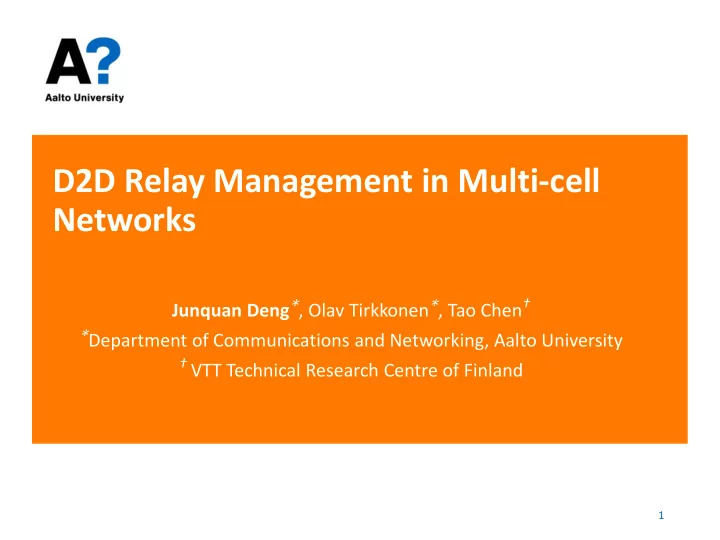

D2D Relay Management in Multi-cell Networks Junquan Deng ∗ , Olav Tirkkonen ∗ , Tao Chen † ∗ Department of Communications and Networking, Aalto University † VTT Technical Research Centre of Finland 1
Relaying based on device-to-device (D2D) communications in cellular networks • Different names in literature D2D relaying UE relaying Mobile relaying UE-to-network/network-to-UE relaying (3GPP) V2V relaying • Applications of D2D relaying Consistent user experience in 5G Cell coverage extension Anti-blockage for mmWave cellular network 2
D2D relaying in multi-cell networks Single-cell model Study the performance of D2D relaying in one cell, no interaction between neighbor cells is assumed. Multi-cell model Consider the interference interaction among neighbor cells, relaying operations in one cell would affect the neighbor cells. Idle UE Active UE Inter-cell downlink interference Direct downlink Inter-cell D2D interference Selected D2D Relay BS UE D2D relaying 3
D2D relaying in multi-cell networks • Challenges Modeling of inter-cell interference with D2D relaying Relay selection and resource allocation for D2D relaying Network management for multi-cell network with D2D relaying • Research consideration Network abstractions are indispensable for capturing the main effects brought by D2D relaying for the practical multi-cell networks 4
Multi-cell network abstraction • Characterize the multi-cell network using a few parameters Minimum inter-site distance D Cell radius R c BS density ρ bs Relaying distance threshold R r Distribution of selected relays r 1 , r 2 D Relay r 1 Relaying probability p r R c d r 2 Pathloss is modeled by two gain UE d functions, 𝑚 𝑐 𝑦 = 𝐿 𝑐 𝑦 −𝜃 for BS-to-UE BS 0 links and 𝑚 𝑒 𝑦 = 𝐿 𝑒 𝑦 −𝜃 𝑒 for D2D links. Both are monotonically decreasing functions of distance 𝑦 , with different pathloss exponents 𝜃 and 𝜃 𝑒 Neighbor cell for downlink and D2D link. 5
Inter-cell interference characterization • Fluid Model : As in Campbell’s theorem , the fluid model transforms an expectation of a random sum over the discrete point process ( PP ) to an integral involving the PP intensity ρ in the distribution area. • In the fluid model, each area element dA contains ρdA interferers which contribute to the aggregate interference. Average aggregate inter-cell DL interference from other BSs D Relay r 1 R c d r 2 UE d BS 0 Distribution of inter-cell DL interference from other BSs is concentrated and predictable. Neighbor cell 6
Inter-cell interference characterization Average inter-cell D2D interference from other cells 𝐽 𝑒2𝑒 𝑒 = 𝑁 𝑒 𝐸 − 𝑒 2−𝜃 𝑒 𝜚 𝑠 2 − 𝜚 𝑠 1 2 − 𝑠 2 )(𝜃 𝑒 − 2 𝑠 2 1 D Relay r 1 R c Distribution of inter-cell D2D d r 2 interference casued by D2D relaying is UE d BS 0 long-tailed and very random. Neighbor cell 7
Inter-cell interference characterization • Aggregate inter-cell DL&D2D interference Probability that one Aggregate DL Probability that one Aggregate D2D BS is transmitting interference relay is transmitting interference on a specific RB on a specific RB When there is no D2D relaying (with 𝑞 𝑠 = 0 ), the interference is 𝐽 𝑒𝑚 𝑒 . When D2D relaying is employed, some transmit power is offloaded from BS to D2D relays which are distributed around the BS. The offloaded power will cause random interference to UE receivers in neighbor cells. 8
Interference-aware D2D Relay Selection and resource allocation • For UE d with a UE-to-BS distance d • There is an estimated DL rate 𝐷 𝑒𝑚 • There is an optimal relay position 𝑒 𝑝𝑞𝑢 • There is an estimated relaying rate 𝐷 𝑓2𝑓 using the optimal relay 9
Iterative interference interaction among neighbor cells • Assmuming a interference-limited scenario. • D2D relay decision in one cell is made based on the observed interference on UEs and relays. • D2D relaying in one cell would change the interference caused to other cells, other cell would change their relaying decisions and hence the observed interference for own cell. Cell X Cellular BS UEs Selected Two-hop A feedback loop exists among Relays UEs multiple cells as a result of the D2D Relay probability P r inter-cell interaction caused by D2D relaying. Cell Y Cell Z Inter-cell D2D Cellular Cellular BS BS interference UEs UEs Selected Two-hop Selected Two-hop Relays UEs Relays UEs Inter-cell Downlink interference D2D Relay D2D Relay probability P r probability P r 10
Control of relaying distance threshold R r • UEs have a distance larger than R r can use D2D relaying service. • R r determines r 1 and r 2 which characterize the D2D interference. • As R r decreases, relaying probability p r increases, and average inter-cell interference decreases (if BS tx power is much larger than UE’s). As inter-cell interference decreases, the population of UEs that can benefit from D2D relaying changes. For a homogeneous network, in equilibrium of R c the network state, we should have: R r 𝐷 𝑒𝑚 𝑆 𝑠 = 𝐷 𝑓2𝑓 𝑆 𝑠 , 𝑒 𝑝𝑞𝑢 (𝑆 𝑠 ) r 1 r 2 11
Simulation parameters 12
Simulation result – search for the relay decision with optimal R r 𝐷 𝑒𝑚 𝑆 𝑠 = 𝐷 𝑓2𝑓 𝑆 𝑠 , 𝑒 𝑝𝑞𝑢 (𝑆 𝑠 ) 13
Simulation result – distribution of selected D2D relays 14
Simulation result – average inter-cell interference 15
Simulation result – distribution of inter-cell interference 16
Simulation result – performance of user throughput D2D relaying increases cell-edge performance significantly. Relaying strategy using the derived value of R r achieves the best performance among all possible values for R r . 17
Summary • Modeling of the aggregate co-channel interference considering D2D relaying is applied in the networks based on a fluid network model. • Several simplified parameters, including a minimum relaying distance and a relaying probability, are proposed to captured inter-cell interaction driven by interference. • D2D relaying management using the derived parameter achieves good performance, especially for cell edge users. 18
Thank you!
Recommend
More recommend